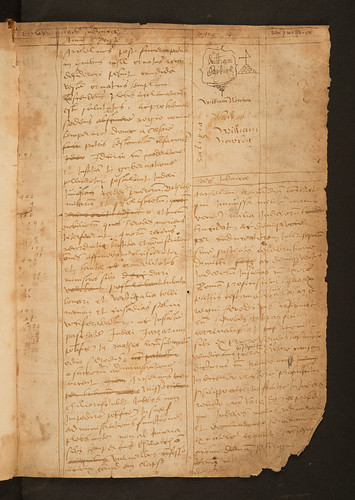Rolewinck, Werner: Fasciculus temporum.
Louvain: Johann Veldener, 29 Dec. [1475].
Fol. [18 2-510 6-88]. [72] leaves.
Woodcuts; woodcut printer’s device.
ISTC ir00256000; GW M38696; Goff R256; Polain (B) 3367A; BMC IX 136 (IB. 49104); Bod-inc R-106; CIBN R-163; BSB-Ink R-233.
| GIP number: | R12 |
| Shelf-mark: | Sp Coll Hunterian Bf.3.17 (see main library entry for this item) |
| Variants: | Variant issue, with record of events between 30 July 1474 and 19 Dec. 1475 added on 8/8v (f. 72v), followed by the colophon printed in red - see Polain(B) 3367A and BMC; 8/8r (f. 72r), col.2, lines 1 and 6: setting as Polain(B) 3367A, except the first word of line 1 reads “Puella” not “Puelle”; 8/8v (f. 72v), line 2: “... coloniēſib[us] ...” not as Polain(B) 3367A “... colonēsib[us] ...”; 1/1r, col. 1, line 3: “... punct[us]” and line 6: “... feliciter” i.e. without the misprints described in BMC’s note. |
| Provenance: | William Baylies (16th/17th century): name “William Baylies” written on front flyleaf, alongside which is his mark incorporating the reversed ‘four’ symbol at the apex of a pyramid of bricks or stones - not listed in E.M. Elmhirst, 'Merchants’ marks' (London: 1959) or in F.A. Girling, 'English merchants’ marks' (London: 1964). William Newton (17th century): name “William Newton” written twice on front flyleaf. William Hunter (1718-1783), physician and anatomist: source unknown. University of Glasgow: Hunterian bequest 1807; Hunterian Museum bookplate on front pastedown, with former shelfmark “Aw.2.8”. |
| Binding: | England, 18th-century quarter calf, marbled paper-covered boards; red leather title label on spine; sprinkled red-edged leaves. Size: 300 x 225 mm. |
| Leaf size: | 295 x 223 mm. |
| Annotations: | Copious marginal annotations, mainly in Latin but occasionally in English, in various 15th/16th-century hands, including a note on the author and his writings by a contemporary dated 1494 in lower margins of 2/1 recto and verso (f. 9); in the upper margin of 2/1r is a quotation “Successor thome suffultus mun[er]e rome hu[n]c sathanas sede rapiet citro m[ihi] crede” (from an anonymous 14th-century Latin poem known as ‘The prophecy of John of Bridlington’); frequent manicules; the recto and verso of the front flyleaf contain chronological notes in Latin in a 16th/17th-century hand on events in the Holy Land in the first years of the Christian era beginning “Archelaus post funera patris”; evidence of signatures in a 15th/16th-century hand in some quires; foliated in a 15th/16th-century hand in the top outer corners “xiij”-“xx/iiij iiij” from 1/1 to 8/8 - suggesting that this work may at an early date have been bound with another work; foliated in a 16th-century hand in the middle of the lower margins “i”-“lxiiij” from 2/1 to 8/8 (ff. 9-72); the same section foliated in a 16th-century hand in the lower outer corners “1”-“64” and the same arabic numbering repeated in a later hand in the upper inner corners. |
| Decoration: | None. |
| Imperfections: | None. |







